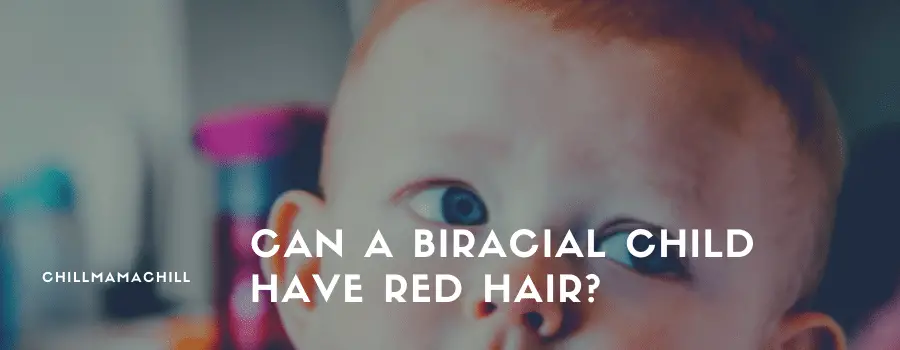Interracial kids inherit the best, and worst of what their diverse cauldron of heritage has to offer. That’s a fact that hits most mums of mixed-race children when they realize they have a ‘ginger’ on their hands soon after delivery. But can a biracial child have red hair, or does it only appear fiery in the first months after birth?
Biracial children inherit both dominant and recessive genetic traits from a wider array gene pool, meaning chances of a carrot top aren’t that slim after all. So, yes, a biracial child can have red hair.
For a trait considered to be the preserve of the Celtic Germanics of northern Europe, you can also find a mixed-race redhead child. Red hair is a non-paramount gene, mutations of which cause various degrees of fiery red, bright brown, or ginger hair pigmentation.
Red hair in an interracial child is nature’s curveball, especially when none of the parent’s hair is anywhere near ginger. For it to show up, your baby needs two copies of a recessive gene commonly found in people with Scottish or Irish ancestry. Read on to see if your biracial tot might get the Ed Sheeran, Lindsay Lohan, or Malcolm X look.
What Causes Red Hair, and Why Is It So Rare?
A Caucasian, possibly female but also male is your probable mental picture of a red-haired person. But fiery carrot-topped kids can pop up anywhere, especially in a multiracial family set-up. You can carry this trait but not express it, so chances of your child having red hair are dependent on you, the parents. Such genetic variants get carried in both families for generations. A copy from each spouse increases the chances of its popping up.

It’s a play of dominance, where if Melanocortin 1 Receptor or MC1R gene is active, eumelanin causes your child to have dark hair and skin. When this recessive gene doesn’t function or gets inhibited, pheomelanin is produced instead, giving rise to blond or red hair, along with freckles.
Such mutations are present in all ethnicities, and according to genetic scientists, there’s nothing more unpredictable than recessive genes. Only a few MC1R mutations cause shades of red hair, for which there are almost eight. That’s out of over 35 traits attributed to polymorphism or specific mutation.
Redheads are present in ethnic black, Latin, and south pacific communities, but these are rarer than your average 13% of Scottish reds. The rest of the world records a sultry 1 and 2 percent compared to the global population. These percentages, despite the lack of conclusive research, point to any corner of the earth from the Caribbean, the orient, and in Negro Africa.
Can a Biracial Child Have Red Hair? What Are the Chances?
For your biracial child to have red hair, both you and your partner must carry a copy of the recessive MC1R gene. Besides the regular northern European redheads or their generations in the Americas, you’ll find the trait in interracial children. Possibilities are that this genetic mutation is original, seeing as pure black people are redheaded.

During Oliver Cromwell’s reign in Britain, himself a redhead, Irish Catholics, and Scottish Celts were deported to the West Indies. The 17th-century massive indenture and voluntary migrations plus the slave trade played a huge part in population displacements. That explains the origin of red hair gene carriers from Africa and the Caribbean since natural selection wouldn’t have favored traits easily harmed by direct sunlight.
It means that even if red hair and pale skin MC1R mutation traits spontaneously appeared in tropic climates, they petered out without spreading. The Caribbean populations were formed mostly out of African and European interaction.
However, that stands for mainly the British as Portuguese and Spaniards ventured further south. It’s the reason you’ll see occasional redheads in black children with both black parents, meaning these have the Celtic mutation that somehow came together in their offspring.
Does Being Red-Headed Put My Biracial Child’s Health at Risk?
MC1R gene mutation isn’t only expressed in hair, since pale freckled skin, and blue eyes fall under its influence. The polymorphism plays a role in pain sensitivity, the immune system, and inflammatory response. While research is still in its infancy, red-headedness is associated with several health issues, including skin cancer.
The pigment pheomelanin, produced from inadequate protective eumelanin, makes red-haired people susceptible to melanoma. While skin cancer risks are present in those with darker hair or skin, it increases in redheads, whether they’re exposed to sunlight or not. Take your biracial carrot top to visit a dermatologist for regular monitoring, especially if you live within the tropics.
Redheads also require more anesthetic for freeze and burn pain, about 19% more than their counterparts with brown hair. Other than the increased sensitivity to thermal change sensations, their senses are dulled when it comes to stinging pain, the injection type. That’s because MC1R genetic mutations can bind endorphins, the body’s natural painkillers.
Unguided stereotypes, such as that a redhead has a feisty fiery personality prevails, but that’s not as damaging as beliefs held by our ancestors. The ancient Egyptians believed that red hair was unlucky, burning carrot top children as a sacrifice to the god Osiris. According to a report on Middle Ages Europe, Malleus Maleficarum, red-haired people were labeled as vampires and witches.
What Else Can Cause Red Hair in a Biracial Child?
Red hair doesn’t only result from the recessive MC1R gene, even in biracial children. Albinism called rufous or ‘type 3,’ contains a phenotype that results in ruddy skin and a red-headed mop. It’s a common mutation in Africa and New Guinea.
Another cause of a biracial child having red hair is a genetic disease that results in adrenal insufficiency, obesity, and a flaming carrot top. Known as Proopiomelanocortin deficiency or POMC, the cellular ratio of pheomelanin to eumelanin is influenced which in effect produces a redhead.
Kwashiorkor is a condition resulting from severe malnutrition, deprivation of calories that lead to excessive hair growth, and de-pigmentation or development of red hair.
Conclusion
Can a biracial child have red hair? The answer is most certainly yes when they inherit two copies of the recessive MC1R gene. It doesn’t matter that none of the parents, or immediate relatives sport carrot tops, red-haired babies are genetic boomerangs from somewhere within their wide-arrayed heritage.

I’m Cathrine and I’m a 39-year-old mother of 3 from Utica, New York. And I’m extremely happy you’ve come to visit my hide-out on the web. Here I post about everything related to family-life and usually it will involve babies and lessons I’ve learned over the years from experts, friends, and my own mistakes. So hopefully you will find what i write fun and informational!


